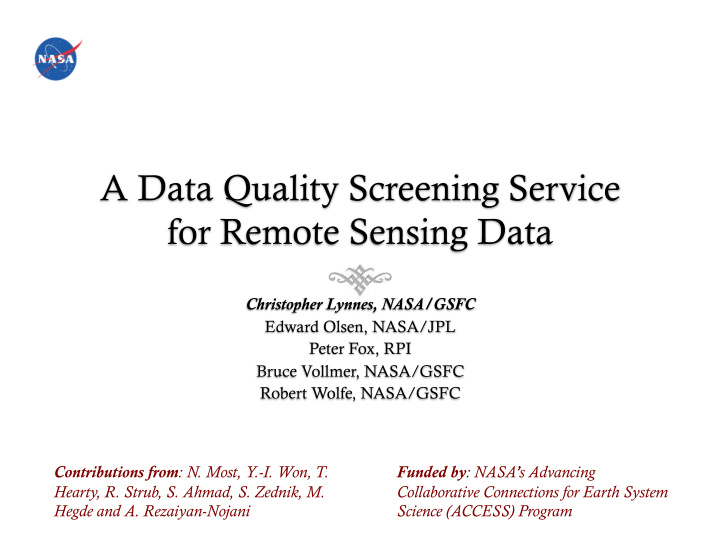



Contributions from : N. Most, Y.-I. Won, T. Funded by : NASA’s Advancing Hearty, R. Strub, S. Ahmad, S. Zednik, M. Collaborative Connections for Earth System Hegde and A. Rezaiyan-Nojani Science (ACCESS) Program
Why a Data Quality Screening Service? Making Quality Information Easier to Use via the Data Quality Screening Service (DQSS) Future Directions for DQSS
AIRS Parameter Best Good Do Not (%) (%) Use (%) Total Precipitable Water 38 38 24 Carbon Monoxide 64 7 29 Surface Temperature 5 44 51 Version 5 Level 2 Standard Retrieval Statistics
Total Column Precipitable Water Qual_H2O kg/m 2 Best Good Do Not Use
Hurricane Ike, viewed by the Atmospheric Infrared Sounder (AIRS) Air Temperature PBest : Maximum pressure for at 300 mbar which quality value is “Best” in temperature profiles
Cloud Mask Day / Snow/ Ice Status Flag Night Flag Flag 0=Undetermined 0=Night 0=Yes 1=Determined 1=Day 1=No Sunglint Flag Cloud Mask Surface Type Flag 0=Yes Cloudiness Flag 0=Ocean, deep lake/river 1=No 1=Coast, shallow lake/river 0=Confident cloudy 2=Desert 1=Probably cloudy 3=Land 2=Probably clear 3=Confident clear Bitfield arrangement for the Cloud_Mask_SDS variable in atmospheric products from Moderate Resolution Imaging Spectroradiometer (MODIS)
Nominal scenario Search for and download data Locate documentation on handling quality Repeat for Read & understand documentation on quality each user Write custom routine to filter out bad pixels Equally likely scenario ( especially in user communities not familiar with satellite data ) Search for and download data Assume that quality has a negligible effect
Hurricane Ike, 9/10/2008 Total Column Precipitable Quality Water Best Good Do Not Use kg/m 2
AIRS Rela)ve Humidity Comparison against Dropsonde with and without Applying PBest Quality Flag Filtering Boxed data points indicate AIRS RH data with dry bias > 20% From a study by Sun Wong (JPL) on specific humidity in the Atlantic Main Development Region for Tropical Storms
Default user scenario Search for data Select science team recommendation for quality screening (filtering) Download screened data More advanced scenario Search for data Select custom quality screening parameters Download screened data
Original data array Mask based on Good quality data (Total column user criteria pixels retained precipitable water) (Quality level < 2) Output file has the same format and structure as the input file (except for extra mask and original_data fields)
Data within product file Best quality only Best + Good quality
AIRS Level 2 Standard Product Use Best-only for data assimilation uses Use Best+Good for climatic studies MODIS Aerosols Use only VeryGood over land Use Marginal+Good+VeryGood over ocean
Initial settings are based on Science Team recommendation. (Note: “Good” retains retrievals that Good or better) . You can choose settings for all parameters at once... ... or parameter by parameter. 16
DQSS is operational for AIRS L2 Standard Products DQSS is offered through the Mirador data search interface at the GES DISC Usage Metrics will be collected: Basic usage What criteria are used Screening invocation is a simple URL GET What the “ yield” was for the screening (future)
Moderate Resolution Imaging Spectroradiometer (MODIS) L2 Atmospheres Microwave Limb Sounder (MLS) L2 Ozone Monitoring Instrument (OMI) L2 High-Resolution Dynamics Limb Sounder (HIRDLS)
Subsetting Reformatting to NetCDF OPeNDAP Suggestions?
Visual- Quick Machine- Routine ization Recon. level Metrics Interdisciplinary X X Educational X X Expert/Power ? X X Applications X Algorithm Developers X
Screening satellite data can be difficult and time consuming for users The Data Quality Screening System will provide an easy- to-use service The result should be: More attention to quality on users’ part More accurate handling of quality information… …With less user effort
Recommend
More recommend